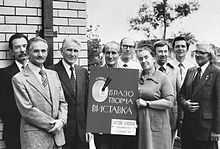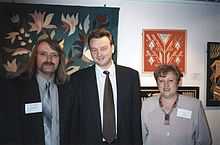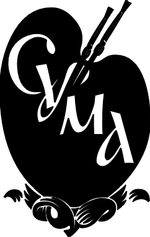Ukrainian Artists Society of Australia
|
Logo of the Ukrainian Artists Society of Australia (NSW) | |
| Abbreviation | СУОМА (in Ukrainian) |
|---|---|
| Formation | 1967 |
| Type | NGO |
| Purpose | promote Ukrainian culture, and especially art |
| Headquarters | Sydney |
Region served | Originally Australia, later only NSW |
Official language | Ukrainian and English |
President | Paul Kravchenko |
The Ukrainian Artists Society of Australia (Ukrainian: Спілка Українських Образотворчих Мистців Австралії) was founded in 1967[1] and was particularly active from the 1960s to the 1970s. As well as the national body, there were a number of other chapters founded in the other Australian states, however, the NSW chapter of the Society, using the acronym СУОМА (НПВ) — "SUOMA (NSW)", was the only society that continued to be active.[2]
Background
Arriving in Australia as migrants after post-World War II Europe, Ukrainian amateur and professional artists contributed to the culture and development of the Ukrainian Australian community, and together with other artists in the arts fields of opera and ballet, have made a significant contribution to the development of the country.[3] They participated in Ukrainian community cultural organisations like Plast, and SUM, but also decorated stages for concerts and theatres, decorated church interiors, designed concert programs, flyers, banners, posters, and logos for various Ukrainian organisations. Some, like Michael Kmit and Leonid Denysenko, were successful as full-time artists.[2][4]
The first major wave of Ukrainian immigrants to Australia began after World War II, arriving in Australia in 1948.[5] Building a Ukrainian community within a new country was a goal for many ethnic Ukrainians who had been displaced by the war, and who refused to return to a homeland controlled by a repressive Soviet communist regime. The newly formed communities brought together professional and amateur actors, musicians, singers,[6][7][8] and visual artists to Australia.[9] Many of them, like Michael Kmit, completed art studies in higher centres of learning in Ukraine or Poland, and some had worked professionally before arriving in Australia. However, in their new chosen homeland they were expected to complete a 2-year work contract in employment chosen by the Australian Government.[10] Many jobs for the immigrant males were physically difficult and were located away from major population centres in isolated villages and farms, and in some cases were demeaning by ignoring the person's profession and skills.[8][11][12] In the early years, the women in the camps lived separately from the men; working in hospitals or in private homes as domestic workers.[13]
Under such conditions, art and painting took on a secondary role,[3] however after the fulfilment of these 2-year contracts the Ukrainian diaspora in Australia immediately began to organize social and cultural life. During the initial temporary camp life period, Ukrainians started to stage theatrical plays, concerts and displays of their craft work.[3] By 1950 Denysenko was already being featured in the Australian Women's Weekly as a migrant artist from Ukraine.[14]
The Ukrainian artists, along with others active in the Ukrainian amateur theatre, opera, and choirs, helped in the difficult task of ‘community building’ in the early years of Ukrainian settlement in Australia. Within a year or two, Ukrainians had formed theatrical societies and choirs in various locations.[15] The theatre became the forum for bringing together diverse artistic talents. Artists like Volodymyr Savchak, Vasyl Tsybulsky, Peter Kravchenko, Borys Spesyvy, Victor Burak, Stefan Chwyla, Yurij Holobrodskyj, Еvhenia Kozalkowska decorated sets and scenery for theatrical productions and concerts that became an important part of Ukrainian cultural and social life.[16][17] Some artists, also participated as actors, while others were also involved in Ukrainian choirs, youth groups, music ensembles and veteran groups.
While most artists were employed in non-artistic related industries, some like Leonid Denysenko found work in Australia in the field of art, either teaching drawing in public and private schools, or in private graphic art firms. Michael Kmit, worked as a porter[12] and cleaner of rail carriages[18] in Sydney while he established himself as "one of Australia's best artists".[19]
History

Although active as individuals, it was only in 1967 that a formal visual artists group was formed, largely through the initiative of Stefan Misko from Canberra.[2][20] Misko travelled to the various states in Australia, seeking Ukrainian artists and forming them into a collective. This group became the Ukrainian Artists Society of Australia (in Ukrainian by the acronym: СУОМА). Stefan Misko was the founder and president of this organisation,[20] Peter Kravchenko (Sydney) became its secretary,[21] and Orion Wenhrynovych (Melbourne) and Aleksander Chubatyj (Sydney) each served as treasurers.
The Society's first exhibition was held on 25–31 August 1967 at the Gallery, Canberra Theatre Centre as part of the Ukrainian National Festival "A Tribute to Australia",[22][23][24] which was opened by the Australian Minister for Immigration Billy Snedden.[25] Nineteen Ukrainian-Australian artists from around Australia took part in this first national exhibition.[22][23]
The golden years
The ‘golden years’ of SUOMA (NSW), when it was the most active, lasted for about 10 years. After 3 months of formation in 1967 it had already staged its first exhibition, and thereafter it had exhibitions once a year until 1976. As well, the Society participated in national exhibitions of SUOMA which were held in 1968, 1971, 1976,[2] as well as participating in the Ukrainian Festival in Canberra in both 1967 and 1972.[2]
Achievements
A notable achievement was the winning entry in 1958 by Leonid Denysenko of a design for a stamp on the theme of immigration in an Australian Government competition.[26][27] In 1968 Leonid and his brother Jurij, won a design competition for an International Memorial-fountain[28][29] to the immigrants who settled in Fairfield,[30] a local government area on the outskirts of Sydney. This monument was erected in the park at the Crescent, Fairfield in 1968.
The ceramic artist Irena Madei also entered the commercial mainstream with her ceramic works.[31][32] Her works have been used as gifts from the Ukrainian community to officials and Olympians on ceremonial occasions.[33]
The most successful of all Australian-Ukrainian artists was Michael Kmit. In 1951, he held his first solo show in Australia at the Macquarie Galleries and received a commendation for his entry in the competition for the new Blake Prize for Religious Art. A year later he took second place in the Blake competition and in 1953 won the prize itself with The Evangelist John Mark.[34]
During the 1950s Kmit's works were exhibited alongside fellow artists from the Society of Artists and the ‘Merioola Group’.[35][36][37][38][39][40][40][41]
There followed a series of awards: the Perth Prize (1954), the Critics' Prize for Contemporary Art (1955), the Darcy Morris Memorial Prize (1956) and the Sulman Prize (1957). Kmit's abstract works were acknowledged as making a significant contribution to the Australian abstract movement by Australian art historians. The Australian artists Paul Haefliger wrote:
- "Of all the foreign aspirants to art who have visited these shores since the war, Michael Kmit is the only one who has made an impression on the present generation of painters."[42]
Kmit's paintings were bought by national galleries as part of their collections.[43]
Revival

Valentin Shkolny came to Australia in 1993 to work privately as a professional photographer, and in 2002 a pictorial book of his black and white photographs titled "Juxtapositions: an Intimate Portrait of Sydney" was published.[44] His photographs are in the collection of the Powerhouse Museum in Sydney,[45] and he was a finalist in the 2004 Australian Photographic Portrait Prize competition.[46] Lialia and Valentin Varetsa were able to receive commissions for illustrating children's books.[47][48][49] Other newly arrived artists Svitlana Soldatova has had solo exhibition in private galleries[50][51] while Natalia Balo, has won local awards,[52] and has given drawing lessons at a regional arts network.[53]
The Society's cultural ties with artists in Ukraine resulted in a number of visits to Australia, some while Ukraine was still under Soviet control. In 1989 artist Ivan Marchuk was invited to Australia, where he gained some success.[54] In 1992 artist-sculptor Anatoly Valiyev visited Australia in 1992 and presenting the Ukrainian community in Australia with a bronze monument to Taras Shevchenko, which was erected in Canberra.[55]
In 1999 the Society held an exhibition in Lidcombe[56] (79 paintings), and another one in 2000 at the Parramatta Heritage Centre gallery titled "Ukrainian Poem".[57]
A notable event was the posthumous commemorative exhibition of Stefan Chwyla's paintings brought to Kiev by fellow artist Peter Kravchenko and displayed at the Museum of Cultural Heritage in 2007.[58]
On 12 April 2009 the Society celebrated its 40th anniversary with a retrospective and current artists exhibition which was launched by the NSW Minister for Local Government Barbara Perry.[59]
Chapters
The Victorian chapter of SUOMA, based in Melbourne, was headed by Vasyl Czybulsky, and after his death Lyudmyla Hrytsenko.[60]
The first annual convention of SUOMA was held in Melbourne in April 1971 as part of the Second Convention of Ukrainians in Australia.[2] This exhibition displayed works by 19 artists, of whom 8 were from Victoria. The most active and the longest-lasting of the various SUOMA groups was the New South Wales chapter. The first members of SUOMA (NSW) were: Michael Sadowskyj (President),[2] Peter Kravchenko (Secretary),[21] Stefan Misko (President of the national SUOMA), Michael Kmit, Leonid Denysenko, Eugenia Koziolkowskyj, Sofia Sywenkyj, Aleksander Chubaty.[2]
During the most active period of the group – the 1960s to 1970s , the role of President was performed by: Michael Sadowskyj, Aleksander Chubaty, Stefan Chwyla,[61] Theodor Nalukowyj and now Paul Kravchenko. The role of Secretary from 1967 till his death was performed by Peter Kravchenko.[21][61]
See also
Notes and references
- ↑ Jars Balan, Stanislav I︠U︡khymovych Lazebnyk (1991). Zarubiz︠h︡ni ukraïnt︠s︡i: dovidnyk. p. 227. ISBN 5-319-00760-4. OCLC 26590744.
- ↑ 2.0 2.1 2.2 2.3 2.4 2.5 2.6 2.7 Pavlyshyn, M. 'Спілка Українських Образотворчих Мистців Австралії' ("Ukrainian Artists Society of Australia"), in Shevchenko Scientific Society Inc. USA and the National Academy of Sciences of Ukraine (1995), Encyclopedia of Ukrainian Diaspora, Vol. 4 (Australia–Asia–Africa). Kiev–New York–Chicago–Melbourne. p.185 ISBN 5-7702-1069-9 (Ukrainian)
- ↑ 3.0 3.1 3.2 Jupp, J. (ed.) The Australian people: an encyclopedia of the nation, its people and their origins, 2nd Edition, Revised, Cambridge University Press, 2001 pp.717–719 ISBN 978-0-521-80789-0
- ↑ Michael Kmit 1910–1981. Cbusartcollection.com.au.
- ↑ History of immigration from Ukraine on Museum Victoria site
- ↑ See for example: 'Ukrainian music in Town Hall' in The Sydney Morning Herald Monday 29 November 1954, p.3
- ↑ List of items at the National Archives of Australia pertaining to Ukrainian opera singer Tais Taras.
- ↑ 8.0 8.1 "Ukrainian Pianist". The Cairns Post (Qld.). 20 December 1948. p. 5. Retrieved 14 November 2014.
- ↑ National Archives of Australia photo of Ukrainian-Australian artist Valentine Lapa restoring historic portraits housed in the Queensland Supreme Court.
- ↑ ''Series notes for series A11902'' describing migrant selection documents for Displaced Persons who travelled to Australia. Naa12.naa.gov.au.
- ↑ "No Talent Best For Migrant.". The Courier-Mail (Brisbane, Qld.). 4 June 1948. p. 5. Retrieved 4 April 2011.
- ↑ 12.0 12.1 "Religious Art Prize Winner Is A Railway Porter.". The Sydney Morning Herald (NSW). 8 April 1953. p. 1. Retrieved 4 April 2011.
- ↑ Nytczenko, D. 'Леонід Денисенко', ("Leonid Denysenko") in «w:uk:Новий обрій» ("New Horizons"), Almanac, Lastivka, Melbourne, 1954 (Ukrainian)
- ↑ ''The Australian Women's Weekly'' Saturday 11 February 1950, p.28–29. Trove.nla.gov.au (11 February 1950).
- ↑ See for example: The Advertiser, Adelaide, Saturday 21 February 1953, p.3
- ↑ Pavlyshyn, Marko (April 1992). "Culture and the émigré consciousness: Ukrainian theatre in Australia 1948–1969". Australasian Drama Studies (20): 56.
- ↑ Kruk, S., Chudakewycz, P. (1994). "Боян (Boyan)". Almanac of Ukrainian Life in Australia. The Free Thought and the Ukrainian Studies Foundation of Australia (in Ukrainian). p. 691. ISBN 0-908168-04-7.
- ↑ Photo of Michael Kmit cleaning trains, from the National Archives of Australia, Image no. : A12111, 1/1953/6/7
- ↑ Harold Holt, Australian Minister for Immigration. "The New Face of Australia", The Rotarian April 1956, p.14 Actually Michael Kmit worked as a railway cleaner – see the above reference to the National Archives of Australia photo no. A12111, 1/1953/6/7
- ↑ 20.0 20.1 'Stefan Misko' in Germaine, M. Artists and galleries of Australia and New Zealand, Lansdowne Editions, 1979 p.386 ISBN 0-86832-019-6, ISBN 978-0-86832-019-9
- ↑ 21.0 21.1 21.2 'Петро Кравченко' ("Peter Kravchenko") in IPREZ (2001), Artists of Ukraine, Issue 2, IPREZ, Kiev. p.111 ISBN 966-95504-0-8 (in Ukrainian and English)
- ↑ 22.0 22.1 Program available from Ukrainian National Festival (Canberra) : programs and related material collected by the National Library of Australia
- ↑ 23.0 23.1 Program available from ACT Heritage Library's Canberra Theatre Centre Ephemera Holdings, 1965–2006
- ↑ 'A happy coincidence' in The Good Neighbour, September 1967, Bulletin for migrants published by the Australian Department of Immigration. For catalog reference see:
- ↑ Photo of opening of the Ukrainian National Festival in 1967. Other photo here
- ↑ 'Holt's dream Australian' Article about the stamp exhibition at the Powerhouse Museum in 1998 of the entries to the 1958 post-war stamp design contest.
- ↑ The collection of stamp entries, including Leonid Denysenko's can be viewed in this collection
- ↑ 'Леонід Денисенко' ("Leonid Denysenko") in IPREZ (2001), Artists of Ukraine, Issue 2, IPREZ, Kiev. p.79 ISBN 966-95504-0-8 (in Ukrainian and English)
- ↑ 'Brothers Win Design', "The Biz", Thursday, 21 March 1968. Fairfield City local newspaper, copies held in Fairfield City library,
- ↑ Western Sydney Regional Organisation of Councils (1982) Sydney's Greater West, Robert Brown & Associates Pty Ltd, Bathurst NSW ISBN 0-909197-18-0
- ↑ "Studio Anna, J. Madei charger, decorated with a Renaissance period lady playing a lute". Carter's Price Guide to Antiques. Retrieved April 3, 2013.
- ↑ 'Irene's ready to see things another way', in Penrith Press, 5 June 2001, p.31
- ↑ Василь Гурмак (Vasyl Hurmak, Professor of Lviv National Academy of Arts). "Свічка пам'яті в Австралії ("The Memorial Flame in Australia")" (in Ukrainian). Retrieved April 3, 2013.
- ↑ Keane, J. 'Man With Two Brushes', A.M.: The Australian Magazine. 28 April 1953 pp.5–6
- ↑ Society of Artists Spring Exhibition Sydney 1952. Society of Artists. 1952.
- ↑ Sydney Nolan et al. (1952). Annual Exhibition Show of Sixes. Society of Artists.
- ↑ Society of Artists' Annual Exhibition. Department of Education Art Gallery, Sydney. Society of Artists. 1953.
- ↑ Margaret Olley et al. (1953). Annual Exhibition Show of Sixes (1953).
- ↑ Society of Artists Annual Exhibition, 1956. Society of Artists. 1965.
- ↑ 40.0 40.1 Society of Artists Exhibition of Drawings and Prints. David Jones’ Art Gallery, Sydney. Society of Artists. 1957.
- ↑ Donald Friend et al. Show of Eights 1957. Macquarie Galleries.
- ↑ Quoted in Robert Hughes, The Art of Australia: a Critical Survey, 2nd ed. Ringwood, Victoria: Penguin, 1970, p. 204.
- ↑ 'Pictures for Art Gallery' in ''The Argus''(Melbourne, Victoria) Saturday 27 March 1954. Trove.nla.gov.au (27 March 1954).
- ↑ Shkolny, V. (2002). "Juxtapositions: an Intimate Portrait of Sydney". Longueville Books. ISBN 9781920681012. OCLC 56340120. Retrieved April 4, 2013.
- ↑ "Photos of Cosmonaut Yuri Gagarin, taken by Valentin Shkolny in the collection of the Powerhouse Museum". Retrieved April 4, 2013.
- ↑ "Photographic Portrait 2004 finalist: Portrait of pianist and composer Miriam Hyde by Valentin Shkolny". Art Gallery of NSW. Retrieved April 4, 2013.
- ↑ For example see: Aesop's Fables, illustrated by Lialia and Valentin Varetsa
- ↑ ''The owl and the pussy cat went to sea'', illustrated by Lialia and Valentin Varetsa. Worldcat.org.
- ↑ List of books on world.cat that have been illustrated by Lialia and Valentin Varetsa. Worldcat.org.
- ↑ Svitlana Soldatova personal exhibition. Gannonhousegallery.com.
- ↑ Svitlana Soldatova's works featured in a Sydneyn restaurant. Angelrestaurant.com.au.
- ↑ Highly commended award for Natalia Balo's work
- ↑ Life drawing classes by Natalia Balo at the Hunter Arts Network. Hunterartsnetwork.org (9 February 2011).
- ↑ "Virtual Dreams of Ivan Marchuk" (4). Welcome to Ukraine. 1999. Retrieved 5 May 2011.
- ↑ ЛАУДА, Лєра (16 August 2007). "Скульптури Анатолія Валієва мають Кучма та Кобзон" (430). Газета по-українськи. Retrieved 5 May 2011. News article about Anatoly Valiyev and his works, including mention of an exhibition in Australia and his bronze sculpture dedicated to Taras Shevchenko, erected in Canberra. (Ukrainian)
- ↑ 'Evening of opportunity' in Review Pictorial, Wednesday 1 December 1999. Civic affairs column by the mayor of Auburn Council C. Le Lam. p.4
- ↑ Augy G. 'Money cannot finance flair' in The Weekend Australian Arts Review section p. 23, 20–21 May 2000
- ↑ Третяк Наталіа (Tretyak Natalia) (September 2007). "Дарунок Києву ("Darynok Kyivu" – Gift for Ukraine)". Українська культура (in Ukrainian) (9 (971)): 8.
- ↑ "Ювілей Асоціації українських художників Австралії ("Jubilee of the Ukrainian Artists Society of Australia")" (in Ukrainian). BBC. 13 April 2009. Retrieved April 4, 2013.
- ↑ 'Осередок Спілки Українських Образотворчих Мистців Автралії у Вікторії', (The cultural centre of the Ukrainian Artists Society of Australia in Victoria) Ukrainians in Australia Vol. 2, Australian Federation of Ukrainian Organisations, Melbourne 1998. p. 333 (Ukrainian) ISBN 0-646-35590-2
- ↑ 61.0 61.1 Australian Department of Immigration and Ethnic Affairs (1987). Directory of Ethnic Community Organisations in Australia. Australian Government Publishing Service. p. 74.
Bibliography
- "The Free Thought" and the Ukrainian Heritage Society in Australia (2001), Ukrainians in Australia: an Encyclopedic Guide (in Ukrainian). Sydney. ІSBN 9780908168118. OCLC 71275847.
- Individual articles in The Free Thought, a Ukrainian-language weekly newspaper issued in Sydney. OCLC 17664565.
